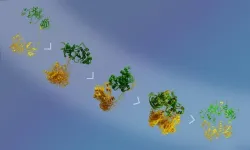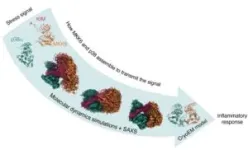(Press-News.org) Constant exposure of cells to stressing agents, such as pathogens, may disturb an organism’s normal functioning. To fight stress, cells have developed several coping mechanisms, including the inflammatory response.
While inflammation is necessary, too much of it can impair cell and organ function. This is the case with cytokine storms – inflammatory cascades during an infection that can spiral out of control and lead to severe disease and even death, as recently highlighted during the COVID-19 pandemic.
In a new paper published in Science, EMBL Grenoble and University of Geneva researchers provide essential insights on a protein called p38α, belonging to the Mitogen Activated Protein Kinase (MAPK) family, which is an important cellular ‘switch’ triggering the inflammatory response. They have obtained the first structure of p38α being activated by another regulatory protein kinase – MKK6 – opening up new directions to develop drugs to stop cytokine storms.
The final switch: a drug target
Matthew Bowler, a researcher at EMBL Grenoble, has been studying kinases for more than a decade. This group of enzymes plays an important role in regulating complex processes in the cell by acting as a ‘switch’ to transmit signals and activate gene expression. They do so by phosphorylation – adding a chemical group, phosphate, to other molecules to modulate their function.
Bowler’s work particularly focuses on MAP kinases, key players involved in the inflammatory response. Inflammation is switched on via a series of kinases, which activate each other in a cascade of reactions, the final kinase in the series being responsible for activating gene transcription required for inflammation. This process releases cytokines, pro-inflammatory signalling molecules, which, in case of overactivation, can lead to cytokine storms.
This kinase chain reaction is well regulated and is similar to a logic circuit: the inflammation response requires specific buttons to be switched on, ultimately activating p38α – the meeting point where all the signals converge and the last switch of the inflammatory process.
Because the kinase chain reaction can come from different ‘branches’ of the logic circuit, this last switch is a particularly relevant drug target. The inflammatory response is regulated by p38α and is highly activated during a cytokine storm. Inactivating it could prevent inflammation from occurring, instead of trying to treat it while it is already underway.
Protein kinases, including p38α, have therefore been heavily studied. The first protein kinase structure was solved 30 years ago – a landmark in the field – and many more structures have followed, with over 7,000 structures now available in the Protein Data Bank.
However, important parts of the puzzles are still missing. “Structural biologists have obtained detailed information on the structure and functions of protein kinases, but mostly in isolation. So we don’t really know how these enzymes are activated along the chain reaction,” explained Bowler.
Without this essential information about how the activation is triggered, drugs have mostly targeted the kinases’ nucleotide-binding site – a common and well-known pocket present in all kinases, where the phosphate transfer occurs. The lack of drug specificity due to a common binding site across kinases means that a drug designed to stop one kinase from signalling could also stop others. This presents a problematic side effect, considering the essential role of kinases as key regulators in cellular processes.
“There are many molecules that have been designed to target p38α, especially its nucleotide-binding site, but none have yet made it past clinical trials due to this lack of specificity,” added Bowler.
Cracking the activation mechanism
Bowler and a former PhD student in his lab, Erika Pellegrini, have therefore been investigating the interactions between p38α and MKK6 - the kinase which activates it - since 2009. But studying the interaction between kinases proves to be extremely complex. “These enzymes are very dynamic molecules; they transmit important signals and need to act quickly. In the case of p38α, it has to go into the nucleus and activate lots of other different proteins,” said Bowler.
They were hampered by the fact that the interactions of the MKK6-p38α complex cannot be determined by macromolecular crystallography, a structural biology technique often employed to investigate proteins but that is particularly challenging to apply in the case of such dynamic proteins.
Recent developments in cryo-electron microscopy (cryo-EM), particularly during the last decade, raised new hopes. In 2016, Bowler and new PhD student and first author of the paper, Pauline Juyoux, decided to switch to this technique – even though the protein complex was at the time considered too small for cryo-EM analysis. They were supported by Pellegrini, who had acquired expertise in this technique.
Tenacity and collaboration were key contributors to project success. "There were a lot of ups and downs, but there were always inspiring people or moments – one of these being particularly memorable,” remembered Juyoux. “We obtained the first low-resolution 3D negative stain model on the exact same day that the Nobel Prize was announced for cryo-EM in 2017. It gave us a boost of motivation!”
Using cryo-EM and complementary techniques, such as X-ray crystallography and small-angle X-ray scattering (SAXS) at the European Synchrotron Radiation Facility and Diamond Light Source, the team managed to obtain the 3D structure of the complex and identify a previously unknown docking site where the two enzymes interact – crucial information for understanding how p38α is activated. “This could be an interesting target for inhibitors that block this specific interaction, and consequently the signal triggering the inflammatory response,” explained Juyoux.
A collaboration with the Gervasio Lab from the University of Geneva, which uses molecular dynamics simulations, supported Bowler, Pellegrini, and Juyoux in giving further insight into how the two kinases interact. “They showed that the model we had generated was compatible with the enzymatic activity and that the phosphorylation site was at the right distance from the active site,” explained Juyoux. “They also classified the different types of conformations of the complex to show how they assemble.”
Crucially, by comparing these simulations with the SAXS data they were able to model how the two proteins interact prior to catalysis. “The beauty of combining the state-of-the-art simulations with SAXS and cryo-EM data through advanced statistical approaches is that we can ‘see’ the dance of the two kinases approaching one another, while knowing that what we see in the computer is fully supported by all the experimental data available,” explained Francesco Gervasio. “The simulations required several months of supercomputing time generously allocated by the Swiss National Supercomputing Centre,” he continued, “But it was well worth it, given the relevance of the final results.”
These results provide an alternative drug target site to explore and also open the door to studying similar processes in two other families of MAP kinases: ERK kinases – which are involved in cancer – and JNK kinases – also involved in inflammation, especially in Alzheimer’s disease.
“Kinases are very similar to one another in terms of sequence and structure, but we don't know how and why they respond or send a specific signal,” said Juyoux, whose current research project as a postdoctoral fellow at Institut de Biologie Structurale in Grenoble focuses on JNK kinases. “Comparing these different families of kinases could help explain the specificity of interactions and lead the way to new therapeutic approaches.”
END
Switching off the cytokine storm
EMBL Grenoble and University of Geneva researchers shed light on the molecular activation of the MAP kinase p38α, the final ‘switch’ triggering the inflammatory response
2023-09-14
ELSE PRESS RELEASES FROM THIS DATE:
Specialised gut immune cells pinpointed that can limit progression of inflammatory bowel disease
2023-09-14
Researchers at the Francis Crick Institute, King’s College London and Guy’s and St Thomas’ NHS Foundation Trust have characterised a specialised type of immune cell, which plays a key role in protecting and repairing the cells in the healthy human gut.
These protective immune cells are depleted in inflammatory bowel disease (IBD), leaving patients vulnerable to disease progression and severe complications. The findings could lead to better clinical management and treatment options for people living ...
Researchers call for major reforms of the UN Sustainable Development Goals: SDG Summit a decisive moment
2023-09-14
On 18-19 September, the United Nations will convene a major summit to review the state of the Sustainable Development Goals (SDGs)—the 17 global goals that governments agreed upon in 2015 to guide action towards a prosperous and just future. With research showing that the SDGs have since then had little political impact, the UN Summit must pave the way for four major changes in how the SDGs are implemented and governed globally, argues an international group of experts in Science.
The article, based on research led by Utrecht University in the Netherlands, brought together a group of scholars with broad expertise in global sustainability governance. “Our ...
Researchers discover tissue-specific protection against protein aggregation
2023-09-14
Key points:
Protein aggregation in certain tissues is a hallmark of diseases such as neurodegeneration and occurs during ageing, but little is known about how protein quality control mechanisms acting to prevent toxic protein build-up vary on a tissue-by-tissue basis.
Dr Della David and her team have discovered a safety mechanism that acts to lower levels of protein aggregation in C. elegans pharyngeal muscles, but is not active in body-wall muscles.
This new mechanism was identified by comparing protein accumulation in different tissues in ageing nematode worms when ...
Genetically modified bacteria break down plastics in saltwater
2023-09-14
Researchers have genetically engineered a marine microorganism to break down plastic in salt water. Specifically, the modified organism can break down polyethylene terephthalate (PET), a plastic used in everything from water bottles to clothing that is a significant contributor to microplastic pollution in oceans.
“This is exciting because we need to address plastic pollution in marine environments,” says Nathan Crook, corresponding author of a paper on the work and an assistant professor of chemical and biomolecular engineering ...
Study explains why certain immunotherapies don’t always work as predicted
2023-09-14
CAMBRIDGE, MA -- This block is broken or missing. You may be missing content or you might need to enable the original module.
Cancer drugs known as checkpoint blockade inhibitors have proven effective for some cancer patients. These drugs work by taking the brakes off the body’s T cell response, stimulating those immune cells to destroy tumors.
Some studies have shown that these drugs work better in patients whose tumors have a very large number of mutated proteins, which scientists believe is because those proteins offer plentiful ...
Growth of large operators threatens existence of grassroots coworking spaces, study warns
2023-09-14
The growing number of large operators and developers opening coworking premises threatens to end the availability of grassroots community-oriented spaces designed to bring isolated workers together, a new study warns.
These coworking communities were originally set up to create serendipitous encounters, knowledge-sharing opportunities, and social capital. But the increasing numbers of big companies running flexible offices means they are less likely to offer services matching these aims.
Smaller operators see the incursion by large commercial real estate developers ...
Using topology, Brown researchers advance understanding of how cells organize themselves
2023-09-14
PROVIDENCE, R.I. [Brown University] — The fact that humans and other living organisms can develop and grow from a single cell relies on a process called embryonic development. For healthy tissue to form, cells in the embryo have to organize themselves in the right way in the right place at the right time. When this process doesn’t go right, it can result in birth defects, impaired tissue regeneration or cancer. All of which makes understanding how different cell types organize into a complex tissue ...
A call for better energy system models to enable a decarbonized future
2023-09-14
Energy system models fail to accurately represent energy storage and might recommend decarbonization strategies that make electric grids less reliable.
Policy makers and utilities need robust energy system models to determine the best strategies to decarbonize the world’s electric grids. But most existing models were designed for grids operating more than a decade ago. Today’s grids are much different. New technologies such as solar power and grid energy storage are being rapidly deployed. To accommodate these and other technologies, utilities must run grids in completely new ways.
Improvements are needed in energy system ...
Stretching the truth: New research reveals negative effects of exaggerative political statements
2023-09-14
Justifying policies through unsubstantiated or slightly invalid arguments can have a significantly negative effect on the public opinion of politicians, according to new research from City, University of London.
With increasing scrutiny on global government policies in a ‘post-truth’ era, and in the aftermath of the Covid-19 pandemic that polarised international responses and reactions to the virus, an increased focus has been placed on policymakers to justify their actions and validate reasons for taking decisions.
Short of lying, this can often politicians “stretching arguments” – making invalid claims that are difficult to both prove and disprove.
The study, ...
Aegis Consortium funds research aimed at reducing the threat of future pandemics
2023-09-14
The Aegis Consortium, an initiative of the University of Arizona Health Sciences, awarded approximately $650,000 in seed funding to eight pilot research projects in the areas of pandemic control, prediction or preparedness; post-acute effects of pandemics on individuals and societies; and the resilience of built and natural environments.
“As we explore the challenges of pandemics such as COVID-19, we will continue to expand our investigative reach with domestic and international research teams to provide a range ...
LAST 30 PRESS RELEASES:
On-demand upgraded recycling of polyethylene and construction of sustainable multifunctional materials based on the "LEGO" strategy
New "Stomata in-sight" system allows scientists to watch plants breathe in real-time
Anorexia nervosa may result in long-term skeletal muscle impairment
Narrative-based performance reviews deemed fairest by employees
New insights reveal how advanced oxidation can tackle emerging water pollutants
New review shows how biomass can deliver low-carbon gaseous fuels at scale
Climate change is quietly rewriting the world’s nitrogen cycle, with high stakes for food and the environment
Study finds SGLT-2 inhibitors linked to lower risk of diabetic foot nerve damage
Microbes may hold the key to brain evolution
Study examines how the last two respiratory pandemics rapidly spread through cities
Gender stereotypes reflect the division of labor between women and men across nations
Orthopedics can play critical role in identifying intimate partner violence
Worms as particle sweepers
Second spider-parasitic mite described in Brazil
January 2026 issues of APA journals feature new research on autism, pediatric anxiety, psychedelic therapy, suicide prevention and more
Private equity acquired more than 500 autism centers over the past decade, new study shows
New cervical cancer screening guidelines from the US Department of Health and Human Services
Estimated burden of COVID-19 illnesses, medical visits, hospitalizations, and deaths in the US from October 2022 to September 2024
Smartphone use during school hours by US youth
Food insecurity and adverse social conditions tied to increased risk of long COVID in children
Earliest, hottest galaxy cluster gas on record could change our cosmological models
Greenland’s Prudhoe Dome ice cap was completely gone only 7,000 years ago, first GreenDrill study finds
Scientific validity of blue zones longevity research confirmed
Injectable breast ‘implant’ offers alternative to traditional surgeries
Neuroscientists devise formulas to measure multilingualism
New prostate cancer trial seeks to reduce toxicity without sacrificing efficacy
Geometry shapes life
A CRISPR screen reveals many previously unrecognized genes required for brain development and a new neurodevelopmental disorder
Hot flush treatment has anti-breast cancer activity, study finds
Securing AI systems against growing cybersecurity threats
[Press-News.org] Switching off the cytokine stormEMBL Grenoble and University of Geneva researchers shed light on the molecular activation of the MAP kinase p38α, the final ‘switch’ triggering the inflammatory response





